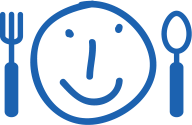Chapter 3 – Guidelines for kindergarten’s healthy and sustainable food program
What does it mean?
- Sustainable food is the one which is produced, processed, bought, sold and eaten in ways that provide social benefits, contribute to thriving local economies that create good jobs and secure livelihoods, and enhance the health and variety of both plants and animals (and the welfare of farmed and wild creatures), protect natural resources such as water and soil, and help to tackle climate change.
- A healthy diet is one that helps to maintain or improve overall health. It provides the body with essential nutrition: fluid, adequate essential amino acids from protein, essential fatty acids, vitamins, minerals, and adequate calories. The requirements for a healthy diet can be met from a variety of plant-based and animal-based foods. A healthy diet supports energy needs and provides for human nutrition without exposure to toxicity or excessive weight gain from consuming excessive amounts.
Please, check for nutrition guides and nutrition facts labels, published by medical and governmental institutions at your country.
- Healthy eating habits refer to a regular and healthy intake of foods derived from plants: vegetables, fruits, whole grains and legumes (beans, peas, lentils) and limit highly processed foods. Healthy eating means eating a variety of foods that give you the nutrients you need to maintain your health feel good and have energy.
- A healthy eating environment is one that environment provides pupils with nutritious and appealing foods and beverages, consistent and accurate messages about good nutrition, and ways to learn about and practice healthy eating. Kindergarten’s staff and parents role modeling has a great emphasis on this environment. By demonstrating healthy eating, they support pupils to realize why is important to consume healthier foods and beverages.
Sample guidelines towards healthy and sustainable food program in kindergartens:
- Adopt a coordinated nutrition policy that promotes healthy eating through classroom lessons, a supportive eating environment and rich outdoor learning experience (Module 1).
- Develop and educational program related to food that lays the foundations of healthy eating patterns, recommends healthy eating and prioritizes the increased daily consumption of fruit and vegetables and healthy weight. Support frequent drinking of fresh, clean tap water (Module 2 link).
- Food safety incorporates the proper food handling from farm to plate, including transport, preparation and storage phases in order to minimise the risk of food-related illness. Most of the process is a subject to the legislation, but not the whole one i.e. preschool social event, preparing and consuming food as a teaching and learning activity etc. Food-related health support for children who have food allergies, food intolerance or special dietary requirements (Module 2).
- Pay special attention to the learning environment (Module 3 and Module 4).
- Foster positive communication and relationships with families to support healthy eating outcomes for children (Module 4 and Module 5).
“We cannot predict children’s futures; but their early education is a powerful tool for building hope.”- Tricia Herbert, United Kingdom, Eco-intelligent education for a sustainable future life, The contribution of early childhood education to a sustainable society, Paris, UNESCO, 2008



